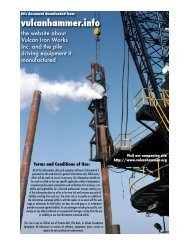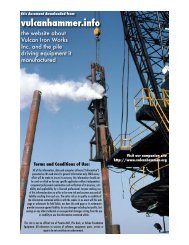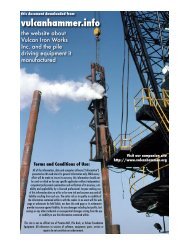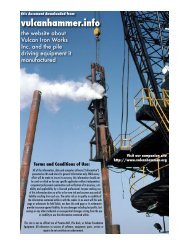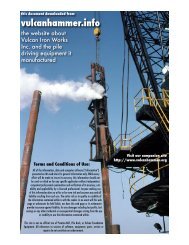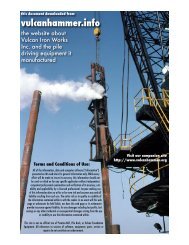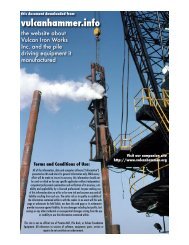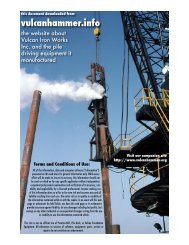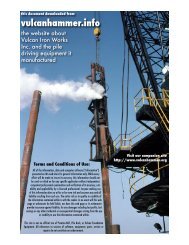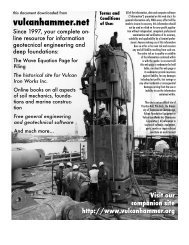Axial Capacity of Driven Piles in Deltaic Soils Using CPT
Axial Capacity of Driven Piles in Deltaic Soils Using CPT
Axial Capacity of Driven Piles in Deltaic Soils Using CPT
You also want an ePaper? Increase the reach of your titles
YUMPU automatically turns print PDFs into web optimized ePapers that Google loves.
this document downloaded fromvulcanhammer.<strong>in</strong>fothe website aboutVulcan Iron WorksInc. and the piledriv<strong>in</strong>g equipment itmanufacturedTerms and Conditions <strong>of</strong> Use:All <strong>of</strong> the <strong>in</strong>formation, data and computer s<strong>of</strong>tware (“<strong>in</strong>formation”)presented on this web site is for general <strong>in</strong>formation only. While everyeffort will be made to <strong>in</strong>sure its accuracy, this <strong>in</strong>formation should notbe used or relied on for any specific application without <strong>in</strong>dependent,competent pr<strong>of</strong>essional exam<strong>in</strong>ation and verification <strong>of</strong> its accuracy, suitabilityand applicability by a licensed pr<strong>of</strong>essional. Anyone mak<strong>in</strong>g use<strong>of</strong> this <strong>in</strong>formation does so at his or her own risk and assumes any and allliability result<strong>in</strong>g from such use. The entire risk as to quality or usability <strong>of</strong>the <strong>in</strong>formation conta<strong>in</strong>ed with<strong>in</strong> is with the reader. In no event will this webpage or webmaster be held liable, nor does this web page or its webmasterprovide <strong>in</strong>surance aga<strong>in</strong>st liability, for any damages <strong>in</strong>clud<strong>in</strong>g lost pr<strong>of</strong>its, lostsav<strong>in</strong>gs or any other <strong>in</strong>cidental or consequential damages aris<strong>in</strong>g from the useor <strong>in</strong>ability to use the <strong>in</strong>formation conta<strong>in</strong>ed with<strong>in</strong>.Visit our companion sitehttp://www.vulcanhammer.orgThis site is not an <strong>of</strong>ficial site <strong>of</strong> Prentice-Hall, Pile Buck, or Vulcan FoundationEquipment. All references to sources <strong>of</strong> s<strong>of</strong>tware, equipment, parts, service orrepairs do not constitute an endorsement.
INVESTIGATIONS LTD.ELECTRIC CONE rENETRAT10N TESTINCAXIAL CAPACITY OF DRIVEN PILES IN DELTAIC SOILS USINGTHE OONE PENETRATION TESTByM.P. DaviesConeTec Investigations Ltd •• Burnaby. B.C •• CanadaP.K. Robertson, R.G. CampanellaUniversity <strong>of</strong> British Columbia, Vancouver, B.C., CanadaA. SyKlohn Leon<strong>of</strong>f Ltd., Richmond, B.C., Canada(prepr<strong>in</strong>t <strong>of</strong> paper to be presented at the)(First International Symposium on Penetration Test<strong>in</strong>g, March 1988)
ABSTRACT: The prediction <strong>of</strong> axial pile capacity is a complex eng<strong>in</strong>eer<strong>in</strong>g problem.Traditional methods <strong>of</strong> data collection and subsequent analyses are frequently <strong>in</strong> errorwhen compared to full-scale load tests. Cone penetration test<strong>in</strong>g (<strong>CPT</strong>) provides ameans by which cont<strong>in</strong>uous representative field data may be obta<strong>in</strong>ed.This paper compares the predictions fram thirteen axial pile capacity .ethods withthe results obta<strong>in</strong>ed from eight full-scale pile load tests on six different piles. Thepiles were steel pipe piles driven <strong>in</strong>to deltaic soil deposits. The thirteen predictionmethods, separated <strong>in</strong>to direct and <strong>in</strong>direct clasaes, used data obta<strong>in</strong>ed from the <strong>CPT</strong> as<strong>in</strong>put for analyses.A brief evaluation <strong>of</strong> each method <strong>in</strong>vestigated i. pre.ented and.the preferred.ethodCs) <strong>of</strong> analyses are identified.1 nmtODUCTIONThe cont<strong>in</strong>ued growth <strong>of</strong> many large Canadianci~ies has led to <strong>in</strong>creased construction <strong>of</strong>larger more complex structures on sites withdifficult around conditions. In Vancouver.as <strong>in</strong> other metropolitan areas, large structuressuch as major highway bridae •• cementprocess<strong>in</strong>g plants. storage tanka and hiahriseresidential and commercial complexe.are nov be<strong>in</strong>g constructed on deltaic andalluvial deposits. Essentially the deltaregion <strong>of</strong> the Fraser River is located immediatelyto the south <strong>of</strong> Vancouver. lbedelta region is covered by a th<strong>in</strong> veneer <strong>of</strong>clays. silts and peats up to about 6 • <strong>in</strong>thickness. which is underla<strong>in</strong> by a tidalflatdeposit <strong>of</strong> sands and silt8 to a maximumthickness <strong>of</strong> 30 •• which <strong>in</strong> turn is underla<strong>in</strong>by stratified mar<strong>in</strong>e delta depositsranc<strong>in</strong>g fram silty clays to clean sands upto 300 III <strong>in</strong> thickness. The groundwatertable is at or near the ground surface. Inthese Fraser River deltaic soil deposits.piled foundations are used extensively tosupport larae structures. The recent construction<strong>of</strong> the Alex Fraser bridge andcorrespond<strong>in</strong>g highway extensions are excellentexamples. In order that a piled foundationmay be designed safely and economically.its behaviour under load must beaccurately predicted and ideally, a fullscalepile load test shoul~.be perfomed.Full-scale load tests are, however. veryexpensive and are therefore <strong>of</strong>ten impractical.Predictive methods for pile capacityrequire an accurate assessment <strong>of</strong> the properties<strong>of</strong> the· soil <strong>in</strong>to which the pile isto be placed. The <strong>CPT</strong> o·ffers an excellentmeans to accurately obta<strong>in</strong> the requiredproperties, especially <strong>in</strong> a<strong>of</strong>t deltaicsoils.A total <strong>of</strong> thirteen static axial pilecapacity methods vere used to predict theresults obta<strong>in</strong>ed frOID eight full-scale pileload test. on aix 4ifferent piles. Thesemethods. aeparated <strong>in</strong>to diTect and <strong>in</strong>directclasses. used data obta<strong>in</strong>ed frCIII the conepenetration test (<strong>CPT</strong>). The <strong>CPT</strong> is a fast.economic and repeatable <strong>in</strong>-situ test. especially<strong>in</strong> loose and s<strong>of</strong>t deltaic aediments.The <strong>CPT</strong> can also be considered to be a modeldisplacement pile.!his paper summari~es the results <strong>of</strong> theeiCht full-scale pile load tests and camparasthese results with the <strong>CPT</strong> predictionsus<strong>in</strong>g the thirteen methods.2 TEST SITEThe test site is located on Lulu Islandwhich is with<strong>in</strong> the post-glacial FraserRiver delta (Fig. 1). .The surficial geology <strong>of</strong> the Lulu Islandregion ia typical <strong>of</strong> a for.mer mar<strong>in</strong>e environmentno longer dom<strong>in</strong>ated by tidalaction. A summary <strong>of</strong> the 80il pr<strong>of</strong>ile at
_.lS!U'• • •Fig. 1. General location <strong>of</strong> research site......IDE _,ie,~.~ ..__ ==~~ __ ~BD~ ~.~~ __ ~the test site to a depth <strong>of</strong> 75 m based ~nsampl<strong>in</strong>g and <strong>CPT</strong> is shovn <strong>in</strong> Fig. 2. Belowa surface layer <strong>of</strong> fill there is a prevalentdeposit <strong>of</strong> organic silty clays to a depth <strong>of</strong>about 15 JD that has been laid down <strong>in</strong> aquiescent swamp or marsh environment. Belowthis upper layer, a medium dense sanddeposit, locally silty. prevails to a depth<strong>of</strong> 30 m. This sand deposit is <strong>in</strong>dicative <strong>of</strong>a high energy depositional period and mostlikely represents a foromer channel bank <strong>of</strong>the Fraser River. Underly<strong>in</strong>g the sand, to adepth <strong>of</strong> up to 150 to 200 m (Blunden. 1975).exists a normally consolidated clayey siltdeposit conta<strong>in</strong><strong>in</strong>g th<strong>in</strong> sand layers. Belowa depth <strong>of</strong> about 60 m the sand layers aremore prevalent and thiCker (up to 1 mthick) • The non-unifomty <strong>of</strong> the depositsbelow 30 m <strong>in</strong>dicates a depOSitional historymost likely consist<strong>in</strong>g <strong>of</strong> alternat<strong>in</strong>g turbulentand quiescent environments associatedwith either tidal flat facies. marg<strong>in</strong>al bankor an alluvial floodpla<strong>in</strong> depositional environment.The <strong>CPT</strong> pr<strong>of</strong>ile <strong>in</strong> Fig. 2 presentsa clear picture <strong>of</strong> the stratigraphie detailat the test site •.. ltTI.IArID IJFn:IIEJfTIAL P.P.'f II) IrAflO 'u/qt11-..... - ........... - .2 0.' - SAND FILLS<strong>of</strong>torvonicsilty CLAYMediumadense SAND:z:~C1..WC!ItNonnollyconsolidatedclore,SILTwith th<strong>in</strong>send Joy.r.S<strong>of</strong>t,normoll,consolidatedcloyey SILTwith SANDloyersFig. 2.Soil pr<strong>of</strong>ile for pile research site. (1 bar • 100 kPa)
Aeross the entire site. 2 to 4 m <strong>of</strong> nonhomogeneousfill exists at the surface. Forthe purpose <strong>of</strong> facilitat<strong>in</strong>g <strong>in</strong>-situ test<strong>in</strong>g,mak<strong>in</strong>g pile driv<strong>in</strong>g possible. and stuay<strong>in</strong>glateral pile behaviour, the fill materialvas removed <strong>in</strong> the general area <strong>of</strong> theresearch piles. This material vas replacedwith clean sand. -Six pipe piles vere driven (four 324 mmdia •• 9.5 mm wall thickness; one 324 mmdia •• 11.5 mm thickness. one 915 mm dia ••19 mm thickness) at the site. The relativeembedments and pile tip conditions <strong>of</strong> thepiles are shown <strong>in</strong> Fig. 3. The five smallerpiles were placed and tested under thesupervision <strong>of</strong> University <strong>of</strong> British Columbia(UBC) personnel. The large pile vasplaced and tested under the supervision <strong>of</strong>the B.C. M<strong>in</strong>istry <strong>of</strong> Transportation andHighways (HOTH). Pile No.1 had a largerdiameter sleeve for the first 2 m to removeany frictional resistance <strong>in</strong> the upper sandfill (see Fig. 3).3 AXIAL PILE LOAD 'l'ESTSapplied <strong>in</strong> roughly 5% <strong>in</strong>crements <strong>of</strong> theanticipated failure load for the piles shown<strong>in</strong> Fig. 3. The 'Quick Load ~est Method' v'used to m<strong>in</strong>imize time-dependent effects.summary <strong>of</strong> the pile driv<strong>in</strong>g and test<strong>in</strong>gscheaule is presented <strong>in</strong> ~able 1.Table 1. UBC/HOliJ pile driv<strong>in</strong>g and test<strong>in</strong>gschedules.PileI Pile Driv<strong>in</strong>g Test<strong>in</strong>gTest Length Date(s} Date(s)No. (m)1 14.3 19 AUG 85 09 NOV 852 13.7 16 AUG 85 01 MAR 853 16.8 16 AUG 85 09 NOV 854 23.2 16 AUG 85 01 !Wt 855 31.1 15 AUG 85; 22 SEl' as:16 AUG 85 06 OCT 85A 67.0 10.11.13 .16. 09 HAY 8417 APR 84B 78.0 11 HAY 84 01 JUN 84C 94.0 09 JUN·84 29 JUN 84The 'Quick Load Test Method' <strong>of</strong> axialload<strong>in</strong>a
Analysis <strong>of</strong> the results from axiallyloaded vertical test piles is more complicatedthan generally realized (Brierley etaI, 1978). For a pile (generally assumed tobe stronger than the soil), the ultimate,failure load is reached when the pileplunges; i.e., rapid settlement occprs undersusta<strong>in</strong>ed or only slightly <strong>in</strong>creased load.This def<strong>in</strong>ition. however. "is <strong>of</strong>ten <strong>in</strong>adequatebecause plung<strong>in</strong>g requires very largedisplacements and is <strong>of</strong>ten less a function<strong>of</strong> the pile-soil system and more a function<strong>of</strong> the capacity <strong>of</strong> the man-pump system(Fellenius, 1980). To be useful. a failuredef<strong>in</strong>ition should be based on a simplemathematical rule that can generate repeatableresults <strong>in</strong>dependent <strong>of</strong> the <strong>in</strong>dividualus<strong>in</strong>g the method and <strong>of</strong> the seale ehosen forplott<strong>in</strong>g the load test data. For example.Fig. 4 shows the results <strong>of</strong> a hypotheticalpile load test plotted to different scales.The hypothetical test pile could be <strong>in</strong>terpreted.based on a visual <strong>in</strong>spection <strong>of</strong> theresults. as a predom<strong>in</strong>antly friction or'float<strong>in</strong>g'. pile (upper figure) or a predom<strong>in</strong>antlyend bear<strong>in</strong>g pile Clower figure).A popular method <strong>of</strong> <strong>in</strong>terpret<strong>in</strong>g axial pileload test data is that by Daviason (197])and <strong>in</strong>volves a simple araphieal manipulation-0.5-Eu1.0z0~ - 1.5(,)IU..J~WQ2.0Q. 2.50t-IU 3.0..J- Q."3.54.000LOA 0 (kN)200 400 600 800 1000 12000Eis2.04,0Fig. 4. Load-displacement diagram <strong>of</strong> hypotheticaltest pile drawn to two differentseales.<strong>of</strong> the theoretical elastic compression l<strong>in</strong>efor the pile <strong>in</strong> question. Davisson's method(1973) has been used <strong>in</strong> this study to determ<strong>in</strong>efailure loads. Fel1enius (1980)studied n<strong>in</strong>e commonly used failure criteriaand found Davisson'S method to be among themost conservative.Fig. 5(a) presents a summary <strong>of</strong> the loaddisplacementtest results for the fivesmaller piles. Based on the telltale datapiles 1, 2 and S are <strong>in</strong>terpreted as predomdnantlyshaft resistance piles whereaspiles 3 and 4 had significantly larger contributionsto their total capacity from endbear<strong>in</strong>g. Pile No. 4 could not be loaded t<strong>of</strong>ailure. but the load-deflection diagram wasbased on the comb<strong>in</strong>ed results <strong>of</strong> the otherpile test results. Fig.SCb) presents asummary <strong>of</strong> the load-displacement results forthe larger pile. The larger pile was testedat three depths (67. 78 and 94 m) as shown<strong>in</strong> Fig. 3. All three test results (Fig. 5b)<strong>in</strong>dicate that the larger pile bas a largeshaft resistance component. The ~eduction<strong>in</strong> measured load observed for the largerpile at 67 m and 94 m depth occurredbecause, with rapid axial deflections. thehydraulic jacks were unable to susta<strong>in</strong> theload. Full details <strong>of</strong> the test program forthe 915 mm pile is given by Robertson et al(1985). A summary <strong>of</strong> the axial load test<strong>in</strong>gis presented <strong>in</strong> Table 2.Table 2. Full details <strong>of</strong> the overall testprogram are given by Davies (1987).Wall Openl Capaci-PileI Length Dia- Thick-. Closed ty (leN)Test meter 'ness LID Ended CDavis-No. (m) (m) (DID) son.1973}1 14.3 0.324 9.5 44 C 1702 13.7 0.324 9.S 42 C 2203 16.8 0.324 9.5 52 C 6104 23.2 0.324 9.5 72 0 12005 31.1 0.324 11.5 96 C 1070A 67.0 0.915 19 73 0 7500B 78.0 0.915 19 85 0 7000C 94.0 0.915 19 103 0 80004 PREDlCTION OF STATlC AXIAL PILE CAPACITY!he prediction methods will be separated asfollows:1) direct methods2) <strong>in</strong>direct methods.The term "direct method" is applied to anystatie predietion method that uses <strong>CPT</strong> data(tip resistance. q~. and/or sleeve friction,
EAXIAL LOA 0 (kN»00~.,~~~4~0~0~;;1~00~:?·90~0~ __ ~~~Z "o ,;: ~~ ./' '~=' 20 . -.-. f._ ,r----.---...l_ ..... e; ..._ ..'\~ 2S <strong>of</strong>~o~ 30III= 35~- zoe: 30~. 40~~ soIIIC 50~o 70t-III 10:90&100,~I •• t.Z.3 .5,(0) use PILE RESEARCH SITEAXIAL LOAD TEST RESULTSTEST C ot t4fttTEST 8 Of T8.. TEST A Of 17 ..LEGEND'I c.,.eit,t ,0. ..... " 1,'13 J\Itia. .... 1 \\\(bJ MOTH PILE RESEARCH SITEFig. S. S1mIII&ry <strong>of</strong> axial load test re.ul U.f" depend<strong>in</strong>g upon -method used) directly bythe use <strong>of</strong> theoretical and/or empiricalscal<strong>in</strong>g factors without the need to evaluateany <strong>in</strong>termediate values (coefficients <strong>of</strong>earth pressure, bear<strong>in</strong>g capacity factors,friction angle, etc.). The scal<strong>in</strong>g factors,<strong>in</strong> all cases, resemble the orig<strong>in</strong>al work <strong>of</strong>de Beer (1963). De Beer (1963) suggestedthat if a probe <strong>of</strong> zero diameter penetratesa soil layer, the device would "feel" theentire effect <strong>of</strong> the lover soil layer iDaediatelyupon penetratiOn. However, if alarge diameter pile vere pushed <strong>in</strong>to thelayer, the po<strong>in</strong>t resistance would not equalthat <strong>of</strong> the zero diameter probe until thepile reached a greater depth. This depth is<strong>of</strong>ten termed the critical depth. De Beershowed that it i. reasonable to assume thatthe pile resistance curve between the layer<strong>in</strong>terface and the critical depth variesl<strong>in</strong>early; thus, the pile resistance at any<strong>in</strong>termediate depth could be determ<strong>in</strong>ed ifboth the idealized penetration resistancecurve and the critical depth were known.Although it is not possible to use a probe<strong>of</strong> zero diameter, the standard electric~\cones (35.7 DID <strong>in</strong> diameter) can be assumedto approximate this condition, especiallyfor large diameter piles. This concept iscomplicated <strong>in</strong> highly layered materialsTable 3.Prediction methods evaluatedDirect lIethods References Notes1. Schmertmann Schmertmann Proven <strong>CPT</strong>and Nott<strong>in</strong>g- (1978)~ethodham <strong>CPT</strong>Cc'c & f. used)2. de Ruiter de Ruiter Europeanand Jer<strong>in</strong>gen and Ber<strong>in</strong>gen (Fugro)<strong>CPT</strong> (1979) (qc & fs used)3. Zhou et a1<strong>CPT</strong>Zhou et al(1982)Ch<strong>in</strong>ese iailwayExperiencee Cic: & fa used)4. Van Hierlo Van !!ierlo Orig<strong>in</strong>al Dutchand lCoppejan and Koppejan (C;c only used)<strong>CPT</strong> (1952) and .Begemann etal (1982)5. Laboratoire LCPC-Busta- French HethodCentral mante and (C;c only used)des Ponts et Gianesa1liChaussees (1982)<strong>CPT</strong> (LefC)6. Belgian <strong>CPT</strong> W .F. Van Impe Belgian Method(1986) (C;c only used)Indirect Methods References Notes7. All RP2A American OffshorePet. Inst.(1980)8. Dennis and Dennia and Modified AlIIOlson Olson(1983a &. b)9. Vijayvergiya Vijayvergiya "A"Hethodand Focht and Focht(1972)10. Burland Burland(1983)ll. JanbuJanbu (1976) NIT12. Heyerh<strong>of</strong> Heyerh<strong>of</strong> Orig<strong>in</strong>alConventional (1976) Bear<strong>in</strong>gTheory13. Flaate andSeInesFlaate andSelnes(1977)NGI
\\ • pu. No.Svhere layer thicknesses are less than the Host pile prediction methods are relativelydifficult and time consum<strong>in</strong>g to implementcritical depth for the large diameter pile.In these situations the full penetration without the aid <strong>of</strong> a computer. This isresistance may be mobilized on the cone but especially true when near'cont<strong>in</strong>uous <strong>CPT</strong>may not be realized for the pile before the data is used. For each <strong>of</strong> the prediction<strong>in</strong>fluence <strong>of</strong> another layer is felt. The way' methods used <strong>in</strong> this study a computer<strong>in</strong> which the different direct methods def<strong>in</strong>e program was written us<strong>in</strong>g commerciallythe critical depth and layer<strong>in</strong>g effects for available spreadsheet s<strong>of</strong>tware. The spreadsheetis seen as a powerful eng<strong>in</strong>eer<strong>in</strong>gboth sleeve friction and po<strong>in</strong>t resistanceis. for the most part. what separates the computational tool that is veIl suited tomethods available.geotechnical eng<strong>in</strong>eer<strong>in</strong>g design. TheAn "<strong>in</strong>direct method" is taken to refer to spreadsheet is particularly well adapted forstatic prediction methods that require perfor.m<strong>in</strong>g sensitivity analyses and thereforerapid evaluation <strong>of</strong> <strong>in</strong>put parameters.<strong>in</strong>termediate correlations <strong>in</strong> order to pre-dict pile capacity from CFT data. It must Perhaps the greatest attraction <strong>of</strong> us<strong>in</strong>gbe realized that. unlike the direct methods. spreadsheets. however. is that the programmer/operatorrequires little computermost <strong>in</strong>direct methods were not formulatedspecifically for use with CFT data. As programm<strong>in</strong>g background.such. any discrepancies between the predictedand measured pile capacities us<strong>in</strong>g capacities for one <strong>of</strong> the direct and one <strong>of</strong>Examples <strong>of</strong> predicted and measured pilethe <strong>in</strong>direct methods may not be due 801e1y the <strong>in</strong>direct methods are shown <strong>in</strong> Figs. 6to problems <strong>in</strong>herent to these methods. and 7. respectively. Fig. 6 shows the LCPCTable 3 lists the thirteen predictive CFT (French) method and Fig. 7 shows themethods evaluated. The first six methods Dennis and Olson (modified API) method.are direct methods whereas the rema<strong>in</strong><strong>in</strong>g Note that the LCPC method predicts theseven are <strong>in</strong>direct methods. In each case capacity <strong>of</strong> both the smaller piles and thethe <strong>CPT</strong> data used was that shown <strong>in</strong> Fig. 2. tests on the larger pile with excellent30PREDICTED PILE CAPACITY (kN)PREDICTED PILE CAPACITY (kN)o 500 1000 1500 2000 2500 00 5000 10000 15000 20000 25000o~~~----~--~----~--~510USC PILESMOTH PILE324mm diameter91!Smm diameterSteel pipe pile.St.el pip. pile15E\%:\..- 20 '\~ 50CLa.J&IJ \Q0 \25 .60""'.\708035 \Short Reliitonci• 90Totol R •• latonce40 100USC PILE RESEARCH SITELCPC <strong>CPT</strong> MethodMOTH PILE RESEARCH SITELCPC <strong>CPT</strong> MethodFig. 6._~lo, ... ~Predicted axial capacity vs. depth for UBC and MOTH pile test sites us<strong>in</strong>g LCPC
agreement. The Dennis and Olson methodpredicts the capacities <strong>of</strong> the smaller pilesquite veIl but significantly overpredictsthe capacities <strong>of</strong> the tests on the largerpile. This trend is seen for all <strong>of</strong> the<strong>in</strong>direct methods evaluated. Results forpile 1 are not <strong>in</strong>cluded <strong>in</strong> Figs. 6 and 7because the predicted pile capaciti~s shown<strong>in</strong>clude the resistance <strong>in</strong> the upper" sandfill vhich vas not act<strong>in</strong>g on pile 1. Topredict the capacity <strong>of</strong> the 915 mm diameterpile at depths greater than 75 m the <strong>CPT</strong>pr<strong>of</strong>ile vas projected assum<strong>in</strong>g a cont<strong>in</strong>uedl<strong>in</strong>ear <strong>in</strong>crease (see Fig. 2). Availableborehole data to a depth <strong>of</strong> 130 m suggeststhis is a reasonable assumption.Fig. 8 summarizes the results <strong>of</strong> all themethods <strong>in</strong> the form <strong>of</strong> bar charts. Forreasons mentioned previously. the resultsfor pile No.1 are not <strong>in</strong>cluded. Note thatboth the direct and <strong>in</strong>direct methods providedreasonable predictions <strong>of</strong> the measuredcapacities <strong>of</strong> the smaller piles. The directmethods, the Zhou et al method to a lesserextent, also predicted the capacity on thelarger pile quite satisfactorily. Hovever,wi thout exception. the <strong>in</strong>direct methods hadpredictions that were significantly <strong>in</strong> errorand non-conservative when compared to themeasured results for the large pile. S<strong>in</strong>cethe <strong>in</strong>direct methods generally did reasonablywell <strong>in</strong> predict<strong>in</strong>g the capacity <strong>of</strong> thesmaller piles. and s<strong>in</strong>ce the piles are all<strong>in</strong> the same deltaic soil deposits, theresults suggest that scale effects areextremely important for the large diameterpile. Host <strong>of</strong> the <strong>in</strong>direct methods areempirical <strong>in</strong> nature and based upon observedresults from piles considerably smaller than915 DID <strong>in</strong> diameter and 100 m <strong>in</strong> length.5 SUMMARY AND CONCLUSIONSThis paper briefly compares thirteen axialpile capacity methods with the results fromeight full-scale pile load tests on sixdifferent piles. The piles were steel pipepiles driven <strong>in</strong>to deltaic soil deposits.The length to diameter ratios (LID) for thepiles ranged from 40 to 100. The measuredaxial capacities ranged from 170 kN to B,OOOleN <strong>in</strong> soils that <strong>in</strong>cluded organic silt. sandand clay.PREDICTED PILE CAPACITY (kN)0°p-~~~0~0 __ ~IOTO~0~1~5rO~0~2_0~0_0_2_~~OOPREDICTED PIL.E CAPACITY (kN)00 ~OOO 10000 15000 20000 25000MOTH PILE91!5mm diameterSteel pipe pile\Tnt A •..T.a, a.T ••• c.\.\ .., \\~Oj.C'.d\, ,\, \\ \\ \, "MOTH PILE RESEARCH SITEDennis and Olson MethodFig. 7. Predicted axial capacity vs. depth for UBC and HOTH pile test sites us<strong>in</strong>gDennis and Olson method.
. t..i.c. ••r •10I: c. II ••f ,•i":• •c•i I• 1f.r .' ..:c • •. II I;.·,i·•I: c... thod 1: Sell_r'IIIO"" ."CS ".U;",holll C'T•••• ,C, •••• ' ••• II,. c ••• el". c.,o 10 .. eo 10 coo 120 '.0 .. 0 '00 100I IIIIII;IIIIIi!-••n'00" MliS121A" •• t~.%".,hod 2: ,. R.iter 0'" .eri",e" e,Sf·• 1I1.,C".,II •• I.,. •• C ••• CI' ....,o 10 .. eo , 00 100 110 •• 0 .00 '10 100..5%....4'SI100.os...10 ... ,0'''' "·14%".thod 3: ZIIo."Zie,Zo.,Lo •• " .. To ... C'T••• D'CT,.'III",.,II,. C".IoC"" c.,-,.io 10 .. eo eo 100· IZO MO '.0 .00 100 "...I11.0,'15I.nI.III.. ,.".,ItlAwe. 140% S'. 34%".tllod ~: Vo" Mierlo 1"11 Ieo ... jo" <strong>CPT</strong>• II'.ICT,.'III.,UII,. C .... C"" c.,0 ao 40 10 eo 100 ItO 140 .. 0 110 ~pc'"I.,IInI101:.,.ITSIII ,. "A .....,. U·21%"Itllod 15: LC,e C'T••'.ICT,.'II,.,U_,. CIo •• CIT" coa,o 10 .. 00 .0 '00 110 MO '10 '00 100 . "II"I'ISI •• I.,00II•.0s'0.10",-100% ".IS%..II'.'CTI.'III .. IIIII. clo •• cn" c~,o 10 .. 10 eo 100 lao '.0 110 '10 100 or.1..,T I"I 111,"I101110'.0Fig. B. Summary <strong>of</strong> predicted va. measuredaxial pile capacity."othod 7: API 111'210•••• ICT ••,..".UII,. C ••• C'T. '"o • .0 10 III , .00 110 '.0 .10 ••,0 100.I sII,;.. .i·•I: co.I: s.. "i·:c •••:a..•• •~.i •• I•cI!i15lSIliS...IS.UllIn"otllod I: D.""i. 0'" 01 ••" A ••·'51" SI.&2".••• I'CT'.'II,Io •••,. CIo.IoC"" c ••o 10 .0 , .. 10 .00 110 '.0 '.0 .eo 100 '"II,II51III1111141104"...I""·'27" U •• 3%.".tllod,: Ylto, ••"I,1 Oft, '~I••••,CT'.'II'•• UII,. C ••• CITY ,
<strong>CPT</strong> data was used for the prediction <strong>of</strong>pile capacity for the thirteen methods evaluated.The direct methods, which <strong>in</strong>corporate<strong>CPT</strong>-pile scal<strong>in</strong>g factors, providedthe best predictions for the piles andmethods evaluated. Based on the results <strong>of</strong>this study the follow<strong>in</strong>g three directmethods are preferred: .1. LCPC <strong>CPT</strong> (Bustamante and Gianesalli,1982)2. de Ruiter and Ber<strong>in</strong>gen <strong>CPT</strong> (1979)3. Schmertmann and Nott<strong>in</strong>gham <strong>CPT</strong> (1978)For the piles tested, the LCPC (French)method is shown to be the best method vi th amaximum error <strong>of</strong> about 2S1, an average error<strong>of</strong> 01. and a standard deviation (Sd) <strong>of</strong> 151.In addition, the LCPC does not directlyrequire the <strong>CPT</strong> sleeve friction value otherthan to def<strong>in</strong>e soil type. "l'his is adesirable feature s<strong>in</strong>ce ~he cone bear<strong>in</strong>g isgenerally obta<strong>in</strong>ed with more accuracy andconfidence than the sleeve friction.When piles are required to be supported <strong>in</strong>s<strong>of</strong>t deltaic soils the <strong>CPT</strong> can be a highlyeconomical.method <strong>of</strong> provid<strong>in</strong>g extensivesubsurface <strong>in</strong>formation to predict axial pilecapacity.The results <strong>of</strong> this study <strong>in</strong>dicate that<strong>in</strong>direct <strong>CPT</strong> methods to predict axial pilecapacity =ay significantly overpredict thecapacity <strong>of</strong> large diameter. long piles (LID> 75) supported <strong>in</strong> s<strong>of</strong>t clayey soils.The assistance <strong>of</strong> the NAtural Sciences andEng<strong>in</strong>eer<strong>in</strong>g Research Council <strong>of</strong> Canada;lOohn Leon<strong>of</strong>f. Richmond: British ColmllbiaM<strong>in</strong>istry <strong>of</strong> Transportation and Highways, <strong>in</strong>particular Mr. Don Fraser: Franki Canada,Richmond: members <strong>of</strong> the USC In-SituTest<strong>in</strong>g Group, and the technical staff <strong>of</strong>the Civil Eng<strong>in</strong>eer<strong>in</strong>g Department, University<strong>of</strong> British Columbia, is very much appreciated.American Petroleum Institute (1980), "RecommendedPractice for Plann<strong>in</strong>g, Design<strong>in</strong>g,and Construct<strong>in</strong>g Fixed Offshore Platforms.API RP lA. 11th edition.Begemann, B.K.S.Ph., Joustra, K., Te Kamp,W.G.B •• Krajicek, P.V.F.S., Heijnen, W.J.,and Van Weele. A.F. (1982), Cone PenetrationTest<strong>in</strong>g. Civiele & Bouwkundige Teehniek.No.3. The Netherlands.Blunden, R.B. (1975), "Urban Geology <strong>of</strong>Richmond, British Columbia." Adventures <strong>in</strong>Earth Sciences Series No. 15, B.C. Govt.Publications.Brierley. G.S., Thompson. D.E., and Eller,C.W. (1979). "Interpret<strong>in</strong>g End- Bear<strong>in</strong>gPile Load Test Results," Behaviour <strong>of</strong> DeepFoundations, AS!H S'l'P 670. RaymondLundgren. Ed •• American Society forTest<strong>in</strong>g and Haterials. pp. 181-198.Burland, J.B. (1973). "Shaft Friction <strong>of</strong><strong>Piles</strong> <strong>in</strong> Clay - A Simple FundamentalApproach." Ground Eng<strong>in</strong>eer<strong>in</strong>g. Vol. 6. No.3, pp. 30-42.Bustamante, M. and Gianeselli, L. (1982)."Pile Bear<strong>in</strong>g <strong>Capacity</strong> Prediction by means<strong>of</strong> .Static Penetrometer <strong>CPT</strong>." PenetrationTest<strong>in</strong>g. ESOP'! II, Amsterdam, Vol. 2, pp.493-500.Davies, M. (1987). "Predict<strong>in</strong>g <strong>Axial</strong>ly andLaterally Loaded Pile Behaviour Us<strong>in</strong>gIn-situ Test<strong>in</strong>g Methods." M.A.Sc. thesis.Civil Eng<strong>in</strong>eer<strong>in</strong>g Dept., University <strong>of</strong>British Columbia, Vancouver, B.C.Davisson, M.T. (1973). "High <strong>Capacity</strong><strong>Piles</strong>," Proceed<strong>in</strong>gs. Lecture Series, Innovations<strong>in</strong> Foundation Construction. ASCI.Ill<strong>in</strong>ois Section, Chicago, 52 pp.de Beer, E.E. (1963), "The Seale Effect <strong>in</strong>Transportation <strong>of</strong> the Results <strong>of</strong> Deep. Sound<strong>in</strong>g Tests on the Ultimate Bear<strong>in</strong>gcapaci ty <strong>of</strong> <strong>Piles</strong> and caisson Foundations,"Geoteehnique. Vol. 8, p. 39.Dennis, N.D. and Olson. R.E. (1983a), "<strong>Axial</strong>capacity <strong>of</strong> Steel Pipe <strong>Piles</strong> <strong>in</strong> Clay," Am.Soc. <strong>of</strong> Civil Ingrs., Geo~eehnical Practice<strong>in</strong> Offshore Eng<strong>in</strong>eer<strong>in</strong>g. Aust<strong>in</strong>, pp.370-387.Dennis, N.D. and Olson, R.E. (l983b), "<strong>Axial</strong>capacity <strong>of</strong> Steel Pipe <strong>Piles</strong> <strong>in</strong> Sand," Am.Soc. <strong>of</strong> Civil Ingrs., Geotechnical Practice<strong>in</strong> Offshore Eng<strong>in</strong>eer<strong>in</strong>g, Aust<strong>in</strong>, pp.389-402.de Ruiter, J. and Ber<strong>in</strong>gen. F.L. (1979),"Pile Foundations for Large North SeaStructures," Mar<strong>in</strong>e Geoteehnology. Vol. 3.No.4. pp. 267-314.Fellenius, B.B. (1980), "The Analysis <strong>of</strong>Results from Rout<strong>in</strong>e Pile Test Load<strong>in</strong>g."Ground Eng<strong>in</strong>eer<strong>in</strong>g, Foundation PublicationsLtd., London, Vol. 13, No.6, pp.19-31.Flaate, K., and SeInes, P. (1977), "SideFriction <strong>of</strong> <strong>Piles</strong> <strong>in</strong> Clay, "Proceed<strong>in</strong>gs <strong>of</strong>N<strong>in</strong>th International Conference on SoilMechanics and Foundation Eng<strong>in</strong>eer<strong>in</strong>g.Tokyo, Japan. Vol. 1, pp. 517-522.Janbu, N.· (1976), "Static Bear<strong>in</strong>g <strong>Capacity</strong><strong>of</strong> Friction <strong>Piles</strong>," Proceed<strong>in</strong>gs <strong>of</strong> theEuropean Conference on Soil Mechanics andFoundation Eng<strong>in</strong>eer<strong>in</strong>g, Vol. 1.2, pp.479-488.Meyerh<strong>of</strong>. G.G. (1951), "The Ultimate Bear<strong>in</strong>gcapacity <strong>of</strong> Foundations," Geoteehnique,Vol. 2. No.4, p. 301.
Meyerh<strong>of</strong>, G.G. (1976), "Bear<strong>in</strong>g <strong>Capacity</strong> andSettlement <strong>of</strong> Pile Foundations," ASCEJournal <strong>of</strong> Geotechnical Eng<strong>in</strong>eer<strong>in</strong>gDivision. Vol. 102. No. GT3. pp. 197-228.Robertson. P.K. Campanella. R.G •• Brown.P.T., Graf, I •• and Hughes, J.H.O. (1985),"Design <strong>of</strong> <strong>Axial</strong>ly and Laterally-Loaded<strong>Piles</strong> Us<strong>in</strong>g Insitu Tests: A Case History,"Canadian Geotechnical Journal. Vol.22. No.4. pp. 518-527.Schmertmann. J.H. (1978). "Guidel<strong>in</strong>es forCone Penetration Test. Perfor.mance andDesign." Federal Highway Adm<strong>in</strong>istration.Report FBWA-TS-78-209. Wash<strong>in</strong>gton. July1978. 145 pp.Van Impe. W.F. (1986), "Evaluation <strong>of</strong> Deformationand Bear<strong>in</strong>g <strong>Capacity</strong> Parameters <strong>of</strong>Foundations from Static <strong>CPT</strong>-Results,"Fourth International Geotechnical Sem<strong>in</strong>aron Field Instrumentation and In-SituTest<strong>in</strong>g. 25-27 November. 1986. S<strong>in</strong>gapore.pp. 1-20.Van Hiarlo, W.C. and Koppejan. A.W. (1952>,"lenita en Draagver.mogen van Beipalen."BoUY. 19 Jan. 1952.Vijayvergiya. V.A. and Focht. J.A •• "A NewWay to Predict <strong>Capacity</strong> <strong>of</strong> <strong>Piles</strong> <strong>in</strong>Clays." Proceed<strong>in</strong>gs <strong>of</strong> Fourth OffshoreTechnology Conference, Houston. Vol. 2,pp. 865-874.%bou. J., Xie. Y., Zuo. Z.S., Luo, H.Y. andTang, X.J. (1982), "Prediction <strong>of</strong> LimitLoad <strong>of</strong> <strong>Driven</strong> Pile by <strong>CPT</strong>." PenetrationTest<strong>in</strong>g. Proc. 2nd European Symp. PenetrationTest<strong>in</strong>g. ESOPT II. Amsterdam, Vol. 2.pp •. 957-961.-,



